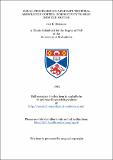Visual processing in a primate temporal association cortex: insensitivity to self-induced motion
Abstract
An animal's own behaviour can give rise to sensory stimulation that is very similar to stimulation of completely external origin. Much of this self-induced stimulation has little informative value to the animal and may even interfere with the processing of externally-induced stimulation. A high-level association area in the temporal cortex of macaque (superior temporal polysensory area, STP) which has been shown to participate in the analysis of visual motion was targeted in a series of experiments in order to investigate whether this brain area discriminates externally- and self-induced stimulation in its visual motion processing. Earlier results in somatosensory processing within this same brain area provided grounds for this presumption The cells studied in here were sensitive to the presence of motion but showed no selectivity for the form of the stimulus. 25% of all visually responsive cells in area STP were classified as belonging to this class of cells. This group of cells was further categorized into unidirectional (39%), bidirectional (4%) and pandirectional (57%) cells. Tuning to direction varied in sharpness. For most cells the angular change in direction required to reduce response to half maximal was between 45 and 70 degrees. The optimal directions of cells appeared clustered around cartesian axes, (up/down, left/right and towards/away). The response latency varied between 35.0-126.4 ms (mean 90.9 ms). On average cell responses showed a transient burst of activity followed by a tonic discharge maintained for the duration of stimulation. 83% of the motion sensitive cells lacking form selectivity responded to any stimuli moved by the experimenter, but gave no response to the sight of the animal's own limb movements. The cells remained, however, responsive to external stimulation while the monkey's own hand was moving in view. Responses to self-induced movements were recovered if the monkey introduced a novel object in its hand into view. That the response discrimination between externally- and self-induced stimulation was not caused by differences in the visual appearance of the stimuli was confirmed in the second experiment where the monkey was trained to rotate a handle connected to a patterned cylinder in order to generate visual motion stimulation over a fixation point. 61% of the tested cells discriminated between pattern motion generated by the monkey and by the experimenter. It was shown that the monkey's motor activity as such (turning a handle without visible cylinder rotation) did not affect the cells' spontaneous activity. Some indication was received to suggest that the discriminative mechanism is using not only (motor) corollary discharges but also proprioceptive input. These results also gave evidence of the plasticity of discriminative processing in STP for the animal's life-time experiences. Finally, the cells were studied for their responsiveness for image motion resulting from movements of external objects and movements of the animal's body (self-motion). 84% of the cells responded only to visual object-motion and failed to respond to visual motion resulting from animal's self-motion. The experiments also revealed that area STP processes visual motion mostly in observer- relative terms, i.e. in reference to the perceiver itself. The results provide one explanation for the functional significance of the convergence of several modalities of sensory (and motor) input in the STP. It is suggested that area STP works as a "neural filter" to separate expected sensory consequences resulting from one's own actions from those that originate from the actions of other animals or environmental events.
Type
Thesis, PhD Doctor of Philosophy
Collections
Items in the St Andrews Research Repository are protected by copyright, with all rights reserved, unless otherwise indicated.

